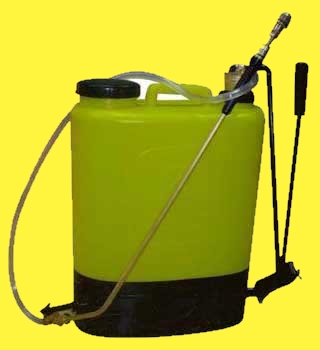Sprayers and Pesticide Application Techniques
There we are. Our crops are in field and now some or other pests or disease is being seen. The required pesticide is also selected. This pesticide is to be applied to the crop so that the disease or pests can be removed. Time proven method has been to spray the pesticide solution over the crop. Nowadays a number of Sprayers are available in the market each with its own benefit and downside.
Sprayer Types
All Sprayers work on the principle of converting spray liquids into droplets. To this end the Sprayers may use hydraulic energy or gaseous energy or centrifugal energy.
One can also differentiate between types of Sprayers– hydraulic and low volume.
In the hydraulic sprayer, a reciprocating pump operated manually by a lever. Compression generated forces the liquid out of nozzle in the form of spray particles.
In a low volume (LV) Sprayers, spray material in water or other carrier is injected into a high speed air stream using fan, blower or compressor. With this sprayer the volume of air in plant canopy is replaced with spray volume, consisting of very small droplets and which affords good coverage.
Hydraulic Sprayers would produce droplets 200 to 400 microns in diameter range whereas LV sprayer would produce in the range of 50 – 100 or even fog size. A human hair is around 100 micron thick.
Some hydraulic Sprayers are:
- Compressed air Sprayers – low spray volume, hand held with nozzle for spot treatment.
- Backpack Sprayers – app 15 liters of spray volume, hand operated pump and a nozzle to spray as the operator walks along.
- Skid mounted Sprayers – 200 liter tank of spray volume
- Tractor mounted Sprayers – large tank size, suitable for wide walk ways
Some LV Sprayers :
- Backpack blower: operated by gasoline engine or dc motor with battery, can hold up to 15 liters of spray solution.
- Electrostatic Sprayers: compressed air carries the spray solution. Good coverage. This is rather a new technique as applied to agriculture may be around 1980s. The spray volume carries a negative charge which latches on the positive charge on the leaves of the plant as opposite charges attract each other. A cocoon of spray forms around the leaves and gives very good canopy penetration. Under leaf coverage is good.
- Fogger: high pressure pump atomizes solution to fog size. May come with a fan also to disperse for larger areas
Dusters:
are Sprayers which spray pesticides or even fertilizers in dust form. The rotary type of duster is provided with an agitator which stirs the powder and releases it evenly through the discharge port. A blower sucks the dust or powder and pushes it forcefully thru a long lance out onto the crop. There are also plunger type dusters and bellows type dusters.
All Sprayers have ultimately a nozzle for delivery of the treatment material. The nozzle atomizes liquid into droplets. It disperses the droplets into specific patterns. Certain momentum is provided to the droplets.
There could be a number of methods to determine the minimum volume of specific pesticide spray per unit area. A rule of thumb some apply is to have at least 20 droplets, irrespective of size of droplets, per square centimeter. However the volume would also change in case of higher temperature, in case infestation was severe to warrant more on leaves, drop let size, equipment being used (generally manual would take more amount than battery or gasoline type sprayers), etc. Sometimes farmer would rather go by his experience than by the rule books.
